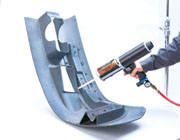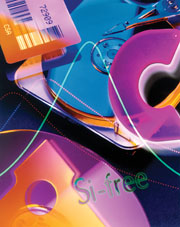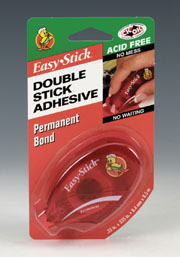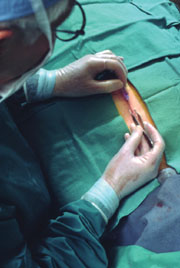
What better way to start the year of our tenth anniversary of publishing ASI magazine than to recap the accomplishments of the adhesives and sealants industry over the past decade? To do this, we tapped into the expertise of our editorial advisory board and others who volunteered to participate.
In some ways, the article is a work in progress. In developing the story, we realize how comprehensive the task at hand is and that there is much that is left untold.
Since this is a celebration that will last all year, we invite you to fill in the gaps. By its very nature, this type of article reflects the opinions of the contributors only and may spark some debate among readers. Please e-mail kramerk@bnp.com with any ideas, suggestions and comments you may have on this energetic industry's noteworthy achievements in recent years.
Meanwhile, we feel that our contributors have done a terrific job in identifying many of the industry trends, and we appreciate their considerable efforts in sharing their opinions with us.
Now, sit back and enjoy the read.

1. What do you see as the most significant accomplishment(s) in the adhesives and sealants industry over the past decade?
Scheeser: Adhesives and sealants continue to find new areas for replacing mechanical fasteners in the transportation, construction and product-assembly industries. Formulators are achieving this while lowering VOCs/raising solids and, where applicable, eliminating the use of chlorinated solvents.
Avalon: Over the past decade, a significant accomplishment in our industry has been the development and commercialization of higher-performance emulsion PSAs to compete with or displace many solventborne adhesive products in specialty applications. This healthy competition will stimulate new developments in the future.
De Stefano: The hot melt tape and label industry appears to be at double-digit growth during the entire decade.
Miller: There is more interaction between suppliers and customers and more information available via Web sites.
Pocius: For the most, keeping ahead of the growth curve. That is, adhesives and sealants have done just about as well as the general economy.

Photo courtesy of 3M, St. Paul, Minn.; http://www.mmm.com
2. What new chemistries or technologies do you feel have impacted the industry?
Dunn: This has not been a decade of major scientific breakthroughs in new molecules or totally new types of adhesives. However, the following have been significant:
• The development and successful applications of reactive hot melt polyurethanes gives the benefits of hot melts, particularly instant fixturing, plus the ability to crosslink with atmospheric moisture to create a thermoset. These adhesives are used in a number of manufacturing areas including panels for recreational vehicles, garage doors, shoes, bookbinding and windows.
• The improved, continued acceptance of relatively safe technologies like UV adhesives.
• The development of high-performance adhesives and sealants for the electronics industry.
• The dedicated efforts of companies to get FDA approval for medical cyanoacrylates. (See sidebar in this feature)
• The development by 3M of acrylic adhesives for bonding polyolefin-based plastics.
Scheeser: Although urethanes do not represent a new chemistry, formulators have made clever use of their versatility by producing a myriad of new or improved products tailored for specific applications to meet market demands. For instance, urethane window sealants have revolutionized automotive design. Even some thermoplastic and rubber-based formulations are being modified with reactive liquid materials such as urethanes to improve rheological and shear-strength properties.
Muny: UV technology and the development of water-based systems that have outdoor resistance.
Avalon: UV/EB processes have enabled development of improved products and increased production efficiencies.
Miller: Reactive hot melts and cool-temperature application of hot melts.
De Stefano: Hot melt systems that can be applied to tapes and labels at speeds unheard of 10 years ago. Crosslinkable one- and two-part hot melt systems particularly for specialty label applications.
Pocius: A new chemistry that has affected the technology of adhesives is the development of adhesives that adhere to low-surface-energy plastics without surface preparation.

3. Can you point to specific product or equipment advances?
Muny: More affordable testing equipment has become available, and training on the equipment is much easier due to the supplier-education programs available.
Scheeser: The wealth of formulation materials, such as polymers, polyols, isocyanates, additives, tackifiers, fillers, UV absorbers, antioxidants, and others, allows for continued product improvement and development of new products for adhesives and sealants markets.
4. What inroads have been made in the workplace with respect to the environment, safety and quality?
Avalon: By containing and managing VOC emissions and using best-available technology, adhesive producers have eliminated exposure issues in the industry.
Dunn: The replacement of VOCs and removal of toxic solvents from adhesives has been a major step. Advances in latex adhesives and 100%-solids adhesives have been important in this regard. Also, the commitment of chemical companies to the principles of Responsible Care has been important.
Miller: Chemists and technicians, as well as plant operators, routinely take job-safety courses.
De Stefano: Generally, there is a greater awareness on the part of individual employees of their responsibilities to their customers, the environment and themselves. Most often, they do not follow orders blindly from bosses. They'll tend to ask more questions before engaging in what may appear to be a problematic situation.
Pocius: Material Safety Data Sheets (MSDSs) are now ubiquitous where once they were hard to find. Much more emphasis has been placed on worker safety at all levels.
Scheeser: Over the past 10 years, our environmental efforts have reduced air emissions, minimized solid-waste generation and improved water quality of plant effluent. Our environmental group also participates in a community advisory panel composed of local industry members and neighbors.
Safety efforts continue to improve in the workplace with investment in safer processes and equipment in combination with focused safety training. New products are designed at the bench level with safety in mind to be sure the chemistries and processes are safe. Also, there has been more cooperation with local municipalities for emergency response.
Through the efforts of our Quality department, we are ISO-certified and see more and more of our customers achieve ISO certification. We continue to make improvements in our plant operations through the use of statistical process control (SPC).
Muny: I think that quality issues may have stood still in some ways. The huge progress was in the decade preceding. The great quality programs of the past have produced a "confirm the process parameters and you don't have to test end product" philosophy. This idea came from the pharmaceutical industry, but the pharmaceutical people cleverly have remembered to test end product as well. Our industry does fewer tests on end products every year (ever ask for a retained sample?), and it shows up in loss of credibility for the system.
5. What part has the Internet played in changing the way our businesses operate?
Muny: The biggest positive I see for our company is the ease of communicating among each other (intra company) and with our clients and customers (inter company). Since our company is an international network of consultants, it has made us far more effective and affordable. The things that used to get written down and saved for a meeting somewhere have been reduced to an e-mail with copies to those concerned and same-day resolution. I think it is fantastic. The downside is the easy dissemination of faulty information. Bad data as well as good data can race around the world in the time it takes to push the "enter" key.
Miller: Information is rapidly available on a global basis. It's made the marketplace more competitive by providing easy access to competitive product data sheets.
De Stefano: Communication is much faster, more accurate and precise, and better decisions are made every day.
Pocius: Information is now much more easy to access. One can find most product information in just a few clicks. In some cases, one can order samples over the Internet without having to contact a salesperson. Also, for many companies, e-commerce is now a reality, and many transactions can take place over the Internet.
Scheeser: The Internet has helped to improve Neville Chemical Co.'s global visibility as well as communications with our customers and vendors. It has helped to improve our communications internally and with our overseas operations and joint-venture partners. For lab work, the Internet is a powerful tool to quickly access information on various chemistries, raw materials, additives and formulations, and the list goes on.

6. Other than the Internet, do you see any other changes in business practices that have either helped or hampered the industry?
Pocius: A significant concern is the lack of funding for academic work in the area of adhesives and sealants. Because of the downturn in the economy, a lot of funding for basic research is drying up. This needs to be addressed because basic knowledge is the lifeblood of innovation and eventually product development.
Muny: Everyone is evaluating dollars spent by the yardstick of "results this year." Americans have been characterized by their lack of investing for long-range results. In 2002, it was even worse. It shows in cuts in quality control and R&D funding, as well as manpower reductions.
Avalon: Economic conditions have led to the elimination of many technical/business resources. The move to outsourcing has created new opportunities, helping to reduce the overall costs of doing business.
De Stefano: Rigid and often confusing local environmental regulations designed by uncompromising activists have been and probably will continue to be the major issue that has hampered growth in developed countries.
Scheeser: Changes in distribution channels for our end-use customers have created a great deal of pressure on pricing. As many of our customers now sell to the "big boxes," they are looking at pricing and service demands that didn't exist just a few years ago. They are passing many of these pressures down the supply chain.

7. What effects have mergers and acquisitions had on the industry, and how do you envision M&A activity in the future?
Muny: Consolidation will eventually stifle change and upgrading because it is often done for financial reasons instead of technical ones. It is great for companies like ours since small companies that can't afford to do research use us as contract R&D partners.
Relying on suppliers to do R&D, QA testing and certification has backfired for two reasons. The customer has cut workforce in these areas and, in doing so, has lost technical depth. Each customer company of the supplier has no technical advantage over its competitors because they all get the same "consolidated" products.
We see quality problems being swept under the rug because the customer companies no longer have the equipment or expertise to detect when they are getting poor quality. The smart customers are demanding third-party confirmation of supplier data.
Lots of new products are being dumbed down so the consumer doesn't get the best product developed but rather the safest from a "simple to produce" aspect. This leaves a tremendous opening for the small-operator entrepreneur to find niche opportunities and restart the cycle.
For example in the acrylic polymer area, people like Herb Wolfson (H&N) and Micky Machier (Beacon) and companies like Dock Resins were leading the innovations. The question is who will replace them as the industry consolidates? Will new entrepreneurs emerge? New entrepreneurs can't afford the huge investments of lab and pilot production so they come to places like Chemsultants to develop their ideas.
Avalon: Industry consolidation has led to lower costs and reduced overhead, but it has also slowed new developments. It requires today's companies to take a sharper focus on the core technologies of each new partner and look for synergy in order to rekindle new product developments and stimulate innovation.
De Stefano: The industry is moving closer to a commodity culture that will force consolidation to reach acceptable returns. While analysts consider it a "Specialty Chemical" business, it really isn't. Returns of 20% on capital employed are rare and probably will not return.
Analysts compare the adhesives and sealants industry to basic chemicals, and perhaps it is a specialty in that sense, but the returns of the basic chemical industry have been reduced to that of coal mining and the stock prices reflect that perception. Consolidation will continue in an attempt to improve earnings. The prospects are limited because of politically unstable geographic areas. China is the great hope.
Dunn: M&A activity has been dramatic over the last 10 years and has created some giant companies, e.g., Henkel Loctite, Bostik Findley and Dow Reichhold. However, the adhesives and sealants industry is still very fragmented worldwide, and I expect much more activity in the next few years.
I also expect these mergers to stifle innovation. However, all is not lost. We will continue to see startup companies specializing in a specific technology or niche market because manufacturing of adhesives is a relatively simple process. Buy a mixer, buy chemicals on the open market and add a bit of creativity and you can create a good business (until the time you get acquired by one of the giants!).
Another thing that has created tremendous price pressure on the adhesives industry is the consolidation of the customer base. We have seen this in the automotive, paper and carpet industries. In fact, this has led to some of the M&A activity in the adhesives industry such as joint ventures between Dow Chemical and Reichhold, Air Products and Wacker-Chemie, and Omnova and Rohm and Haas.
Scheeser: M&A activity over the last several years has changed the industry at all levels. We have seen our raw material suppliers consolidate, resulting in fewer sources and choices of key products. Our customer base has also consolidated. Finally, we have seen a significant change in our competitors as a result of the M&A activity. This has caused shifts in our long-term plans as we see these organizations change their focus. This, combined with the sour economy, has complicated plans as to how, where and when to allocate scarce resources.
Overall, these changes have resulted in larger organizations that wield more clout in their respective market positions. In many respects, the synergies created by these acquisitions have provided them with improved costs and access to new markets for the new organization. However, from the standpoint of a raw material supplier, the acquisition of a company usually signals the demise of many hours of our time in helping to develop new products as these companies direct their efforts to rationalize their personnel, product lines and production facilities.
We think M&A activity will continue as most companies will continue to grow market share globally. Acquisitions and joint ventures are far less costly and have the potential for quicker payback than trying to develop a market from scratch.
Pocius: Multiple mergers have consolidated some of the commercial and technical power in just a few companies. There have also been some divestitures of companies in the raw materials area. This has led to some degree of confusion among formulators.

8. How and where have the markets for adhesives and sealants shifted over the past 10 years?
Miller thinks that adhesives for hygienics will challenge packaging adhesives over the long haul. De Stefano points out that the patent literature tends to support the trend to hot melts at a faster rate than water-based adhesives. Within hot melts, he feels there are more specialty uses for polyurethane systems.
Dunn: From a regional point of view, consumption is still dominated by North America and Europe, and growth will parallel growth of the GDP in these regions. China is the future growth market, and many U.S. and European companies have established operations and joint ventures there.
From an applications point of view, the market is still dominated by the traditional areas such as packaging and construction, although automotive applications for adhesives have increased significantly. Electronics has been a significant growth market over the last 10 years and will continue to grow. Medical application market for adhesives is small but expected to grow significantly in the future.
Pocius agrees with Dunn that the growth markets seem to be moving to China...and Eastern Europe. Continuing economic weakness in Japan, says Pocius, is a concern for all.
Scheeser: A growing market for adhesives over the last 10 years has been to bond plastics. More manufacturers are switching from metal to plastic parts to lower costs and weight such as in the transportation and product-assembly industries. Adhesives are preferred over mechanical fasteners for bonding plastics in aircraft, autos, trucks, recreational vehicles and computers, to name a few, since adhesives dissipate stress more evenly, giving a more reliable assembly. Also, without mechanical fasteners, the aesthetics of the product is improved.

9. Has our industry been successful in achieving a global presence?
Muny: It's just like the days of Korea in the '50s and Formosa turning into Taiwan and us following the French into Vietnam. American business doesn't have a clue on how to globalize by understanding what is going on in the trenches. Our industry still tries to grow at the "Director" level instead of the formulator and chemist entrepreneur level. It works OK in the United States, but it only works overseas when we throw obscene amounts of money into a venture and upset the natural balance of development in the marketplace. That fosters resentment and exploitation while we sit at home and are pleased because the numbers tell us we are succeeding. As a consulting and contract R&D company, we see the grass roots needs still being addressed by local entrepreneurs who see some U.S. companies as customers only.
Avalon: Many companies have gone global with leaders in a number of sectors paving the way for smaller companies to follow. Examples include giants in consumer products such as Procter & Gamble, Johnson & Johnson and Kimberly-Clark, and electronics companies like Sony and Phillips. Adhesive label and tape companies have followed their growth by putting in sales offices, then distribution and eventually manufacturing operations around the world.
De Stefano: Not really. If we think of the global region as the Americas, Western Europe and parts of Eastern Europe, China and the six tigers then, yes, we have achieved global presence even if we have ignored Islamic countries and India. Those areas cannot be fully developed without a fundamental change in culture. For now, they remain a black hole.
Dunn: It is on the way to achieving this - unfortunately adhesives and sealants are not glamorous items of commerce. Although many of the items we buy are held together by adhesives, they are rarely seen or talked about. However, some companies are trying to establish global brands, particularly on the consumer side - good examples are Post-It® notes from 3M and Pritt® Glue Sticks from Henkel.
Scheeser: I think it has, and part of it is due to large, multinational companies purchasing small regional ones and bringing them into the global arena. Many adhesive producers and suppliers are investing in China and Latin American to try and gain share in their explosive packaging demand.

Sidebar:
Cyanoacrylate Adhesives Changing the Face of Surgical-Wound Closures
By Dr. David Dunn, Senior Associate, bms North America, Aurora, Ohio
The use of adhesives in surgery goes back to the Vietnam War when MASH units were losing many patients who were suffering from grave wounds of the chest or abdomen and bled to death before surgery could be performed.
Cyanoacrylates had been invented and developed by Dr. Harry Coover and his team at Eastman Chemical. A special surgical team experienced almost miraculous results by spraying cyanoacrylates on the wounds, stopping bleeding almost instantly and allowing time to treat the wounds by conventional means. Thus, a revolutionary advance in surgical procedures was demonstrated, and many were saved who would have died.
However, the development of these adhesives was frustrated for over 30 years in the United States by the inability to get FDA approval, mainly on the grounds that foreign objects implanted in the body might cause cancer many years into the future. In the late 1990s, approval was finally received in the United States for cyanoacrylates for external (or "topical") applications.
Cyanoacrylate adhesives have proved beneficial in the following medical procedures, mainly outside the United States:
• Sutureless surgery, particularly in rejoining veins, arteries or intestines;
• Ophthalmic surgery to seal punctures or lesions in the eyeball with sight-saving results;
• Cosmetic surgery that reduces scarring by replacing or supplementing sutures;
• Sealing bleeding ulcers to protect them from stomach acids while healing proceeds;
• Repairs of soft organs, lung lesions, and the like, which is easier than by conventional methods;
• Dental surgery for sealing tooth sockets after extractions and in periodontal surgery where postoperative pain is greatly reduced.
The two leading cyanoacrylate adhesives are Dermabond (developed by Closure Medical Corp. and marketed by Ethicon, Inc.) and Indermil (developed by Loctite Corp. and marketed by the USS/DG Division of United States Surgical, a division of Tyco Healthcare Group). Other providers of medical-grade cyanoacrylate products targeting this market opportunity include GEM/Biovascular, B. Braun Melsungen, Medlogic Global, Chemence and GluStitch.
We can expect approval of adhesives for internal-wound management in the near future. Some analysts are predicting a multibillion industry developing over the next 10 years.
